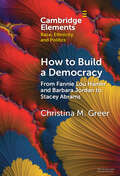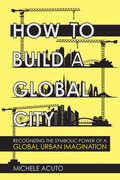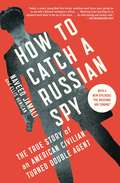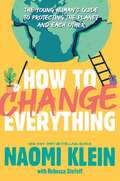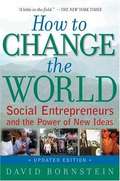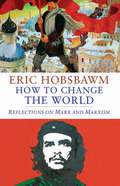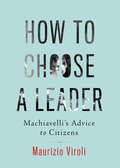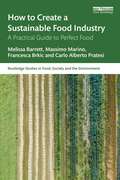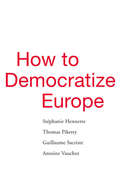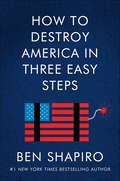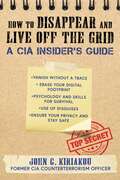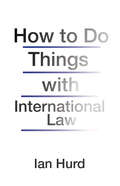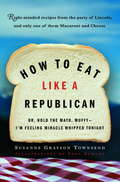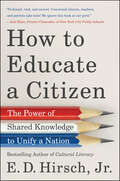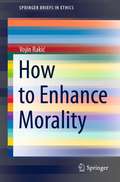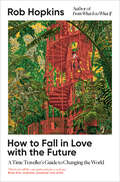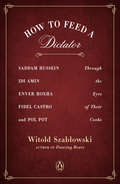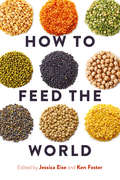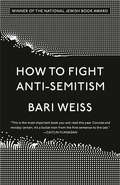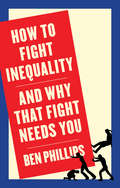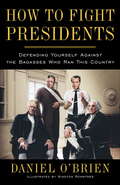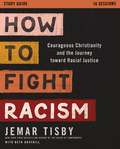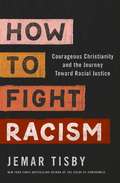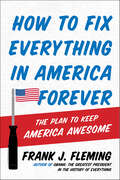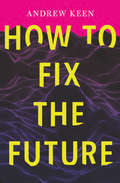- Table View
- List View
How to Build a Democracy: From Fannie Lou Hamer and Barbara Jordan to Stacey Abrams (Elements in Race, Ethnicity, and Politics)
by Christina M. GreerFrom the toils of Fannie Lou Hamer and Barbara Jordan emerges a twenty-first-century leader, Stacey Abrams. This Element explores the strategic organizing acumen of Fannie Lou Hamer in Mississippi and across the South, and the rise of Barbara Jordan, the second Black woman elected to the House of Representatives and the first Black woman from the US South to head to Congress. The leadership skills and collective political efforts of these two women paved the way for the emergence of Stacey Abrams, candidate for governor of Georgia in 2018 and 2022, and organizer of an electoral movement that helped deliver the 2020 presidential victory and US Senate majority to the Democratic Party. This Element adds to the existing literature by framing Black women as integral to the expansion of new voters into the Democratic Party, American democracy, and to the political development of Black people in the US South.
How to Build a Global City: Recognizing the Symbolic Power of a Global Urban Imagination
by Michele AcutoIn How to Build a Global City, Michele Acuto considers the rise of a new generation of so-called global cities—Singapore, Sydney, and Dubai—and the power that this concept had in their ascent, in order to analyze the general relationship between global city theory and its urban public policy practice.The global city is often invoked in theory and practice as an ideal model of development and a logic of internationalization for cities the world over. But the global city also creates deep social polarization and challenges how much local planning can achieve in a world economy. Presenting a unique elite ethnography in Singapore, Sydney, and Dubai, Acuto discusses the global urban discourses, aspirations, and strategies vital to the planning and management of such metropolitan growth.The global city, he shows, is not one single idea, but a complex of ways to imagine a place to be global and aspirations to make it so, often deeply steeped in politics. His resulting book is a call to reconcile proponents and critics of the global city toward a more explicit engagement with the politics of this global urban imagination.
How to Catch a Russian Spy
by Ellis Henican Naveed JamaliThe fascinating story of a young American amateur who helped the FBI bust a Russian spy in New York--sold in ten countries and in a major deal to 20th Century Fox.For three nerve-wracking years, Naveed Jamali spied on America for the Russians, trading thumb drives of sensitive technical data for envelopes of cash, selling out his own beloved country across noisy restaurant tables and in quiet parking lots. Or so the Russians believed. In fact, this young American civilian was a covert double agent working with the FBI. The Cold War wasn't really over. It had just gone high-tech. How to Catch a Russian Spy is the one-of-a-kind story of how one young man's post-college adventure became a real-life US counter-intelligence coup. He had no previous counter-espionage experience. Everything he knew about undercover work, he'd learned from Miami Vice and Magnum P.I. reruns and movies like Ronin, Spy Game, and anything with Bond or Bourne in the title. And yet, hoping to gain experience to become a Navy intelligence officer, he convinced the FBI and the Russians they could trust him. With charm, cunning, and a big load of naiveté, he matched wits with a veteran Russian military-intelligence officer who was recruiting spies on American soil, out-maneuvering the Russian spy and his secret-hungry superiors. Along the way, Jamali and his FBI handlers cast a rare light on espionage activities at the Russian Mission to the United Nations in New York and earned a solid US win in the escalating hostilities between Moscow and Washington. Now, Jamali reveals the whole engaging story behind his double-agent adventure--from coded signals on Craigslist to the Russian spy's propensity for Hooters' Buffalo wings. Cinematic, news-breaking, and wildly entertaining, How to Catch a Russian Spy is an armchair spy fantasy brought to life. Film rights sold to 20th Century Fox for director Marc Webb (The Amazing Spider-Man, 500 Days of Summer).
How to Change Everything: The Young Human's Guide to Protecting the Planet and Each Other
by Naomi KleinAn empowering, engaging young readers guide to understanding and battling climate change from the expert and bestselling author of This Changes Everything and On Fire, Naomi Klein.Warmer temperatures. Fires in the Amazon. Superstorms. These are just some of the effects of climate change that we are already experiencing. The good news is that we can all do something about it. A movement is already underway to combat not only the environmental effects of climate change but also to fight for climate justice and make a fair and livable future possible for everyone. And young people are not just part of that movement, they are leading the way. They are showing us that this moment of danger is also a moment of great opportunity—an opportunity to change everything. Full of empowering stories of young leaders all over the world, this information-packed book from award-winning journalist and one of the foremost voices for climate justice, Naomi Klein, offers young readers a comprehensive look at the state of the climate today and how we got here, while also providing the tools they need to join this fight to protect and reshape the planet they will inherit.
How to Change the World: Social Entrepreneurs and the Power of New Ideas
by David BornsteinNow published in more than twenty countries, David Bornstein's How to Change the World has become the bible for social entrepreneurship--in which men and women around the world are finding innovative solutions to a wide variety of social and economic problems. Whether delivering solar energy to Brazilian villagers, expanding work opportunities for disabled people across India, creating a network of home-care agencies to serve poor people with AIDS in South Africa, or bridging the college-access gap in the United States, social entrepreneurs are pioneering problem-solving models that will reshape the 21st century. How to Change the World provides vivid profiles of many such individuals and what they have in common. The book is an In Search of Excellence for social initiatives, intertwining personal stories, anecdotes, and analysis. Readers will discover how one person can make an astonishing difference in the world. The case studies in the book include Jody Williams, who won the Nobel Peace Prize for the international campaign against landmines she ran by e-mail from her Vermont home; Roberto Baggio, a 31-year old Brazilian who has established eighty computer schools in the slums of Brazil; and Diana Propper, who has used investment banking techniques to make American corporations responsive to environmental dangers. The paperback edition will offer a new foreword by the author that shows how the concept of social entrepreneurship has expanded and unfolded over the last few years, including the Gates-Buffett's charitable partnership, the rise of Google, and the increased mainstream coverage of the subject. The book will also update the stories of individual social entrepreneurs that appeared in the cloth edition.
How to Change the World: Tales of Marx and Marxism
by Eric HobsbawmIn the 144 years since Karl Marx's Das Kapital was published, the doctrine that bears his name has been embraced by millions in the name of equality, and just as dramatically has fallen from grace with the retreat of communism from the western world. But as the free market reaches its extreme limits in the economic and environmental fallout, a reassessment of capitalism's most vigorous and eloquent enemy has never been more timely. Eric Hobsbawm provides a fascinating and insightful overview of Marxism. He investigates its influences and analyses the spectacular reversal of Marxism's fortunes over the past thirty years.
How to Choose a Leader: Machiavelli's Advice to Citizens
by Maurizio ViroliOne of the greatest political advisers of all time, Niccolò Machiavelli thought long and hard about how citizens could identify great leaders--ones capable of defending and enhancing the liberty, honor, and prosperity of their countries. Drawing on the full range of the Florentine's writings, acclaimed Machiavelli biographer Maurizio Viroli gathers and interprets Machiavelli's timeless wisdom about choosing leaders. The brief and engaging result is a new kind of Prince--one addressed to citizens rather than rulers and designed to make you a better voter. Demolishing popular misconceptions that Machiavelli is a cynical realist, the book shows that he believes republics can't survive, let alone thrive, without leaders who are virtuous as well as effective. Among much other valuable advice, Machiavelli says that voters should pick leaders who put the common good above narrower interests and who make fighting corruption a priority, and he explains why the best way to recognize true leaders is to carefully examine their past actions and words. On display throughout are the special insights that Machiavelli gained from long, direct knowledge of real political life, the study of history, and reflection on the political thinkers of antiquity. Recognizing the difference between great and mediocre political leaders is difficult but not at all impossible--with Machiavelli's help. So do your country a favor. Read this book, then vote like Machiavelli would.
How to Create a Sustainable Food Industry: A Practical Guide to Perfect Food (Routledge Studies in Food, Society and the Environment)
by Massimo Marino Melissa Barrett Francesca Brkic Carlo Alberto PratesiThis book presents a practical guide to help businesses navigate the complex topics of sustainability in the food industry. The book takes you on a journey along the food value chain, from farm to fork, exploring key opportunities to increase positive impacts and circularity at each step of the journey. Written by a team of authors with decades of experience in the food industry and academia, it provides guidance on how to analyse sustainability across the value chain and life cycle of a food product and how to design, implement and communicate strategies to customers. Furthermore, the book shows that there are not always straightforward solutions, but rather choices and trade-offs that require an understanding of what is best suited to the product, customers and business in question. It demystifies a variety of topics, such as local sourcing, regenerative agriculture, plant-based protein and the environmental impact of meat production, and draws on a wide range of case studies from across the globe, to provide concrete, real-world examples. While a perfect food system may not exist, informed decisions can go a long way to reshape and transform the food industry as we know it. This book will be of great interest to professionals working in the food and agriculture industries, as well as students and scholars of sustainable food systems and sustainable business.
How to Democratize Europe
by Stéphanie HennetteAn all-star cast of scholars and politicians from Europe and America propose and debate the creation of a new European parliament with substantial budgetary and legislative power to solve the crisis of governance in the Eurozone and promote social and fiscal justice and public investment.
How to Destroy America in Three Easy Steps
by Ben ShapiroA NEW YORK TIMES BESTSELLER!A growing number of Americans want to tear down what it’s taken us 250 years to build—and they’ll start by canceling our shared history, ideals, and culture.Traditional areas of civic agreement are vanishing. We can’t agree on what makes America special. We can’t even agree that America is special. We’re coming to the point that we can’t even agree what the word America itself means. “Disintegrationists” say we’re stronger together, but their assault on America’s history, philosophy, and culture will only tear us apart.Who are the disintegrationists? From Howard Zinn’s A People’s History of the United States to the New York Times’ 1619 project, many modern analyses view American history through the lens of competing oppressions, a racist and corrupt experiment from the very beginning. They see American philosophy as a lie – beautiful words pasted over a thoroughly rotted system. They see America’s culture of rights as a façade that merely reinforces traditional hierarchies of power, instead of being the only culture that guarantees freedom for individuals.Disintegrationist attacks on the values that built our nation are insidious because they replace each foundational belief, from the rights to free speech and self-defense to the importance of marriage and faith communities, with nothing more than an increased reliance on the government. This twisted disintegrationist vision replaces the traditional “unionist” understanding that all Americans are united in a shared striving toward the perfection of universal ideals.How to Destroy America in Three Easy Steps shows that to be a cohesive nation we have to uphold foundational truths about ourselves, our history, and reality itself—to be unionists instead of disintegrationists. Shapiro offers a vital warning that if we don’t recover these shared truths, our future—our union—as a great country is threatened with destruction.
How to Disappear and Live Off the Grid: A CIA Insider's Guide
by John KiriakouWith an experienced CIA officer as your teacher, you&’ll gain the knowledge and necessary tools to protect yourself and the ones you love.No matter where we go, we leave tracks and clues of our existence without even knowing. Our electronic footprint becomes our invisible trail. In this day in age where the world seems to be at our fingertips and social media plays a huge role in our daily lives, it&’s hard not to leave part of our digital selves for others to find.Whether you&’re fascinated by the idea of disappearing, want to erase your digital footprint, or simply concerned about your safety and privacy, knowing how to become invisible is a survival skill that will come in handy.Through the easy-to-follow instructions, tips, tricks, and professional anecdotes in How to Disappear and Live off the Grid: A CIA Insider's Guide, you&’ll learn to vanish without a trace from John Kiriakou, a former CIA counterterrorism officer and senior investigator for the Senate Foreign Relations Committee responsible for the capture of Abu Zubaydah.
How to Do Things with International Law
by Ian HurdA provocative reassessment of the rule of law in world politicsConventionally understood as a set of limits on state behavior, the “rule of law” in world politics is widely assumed to serve as a progressive contribution to a just, stable, and predictable world. In How to Do Things with International Law, Ian Hurd challenges this received wisdom. Bringing the study of law and legality together with power, politics, and legitimation, he illustrates the complex politics of the international rule of law.Hurd draws on a series of timely case studies involving recent legal arguments over war, torture, and drones to demonstrate that international law not only domesticates state power but also serves as a permissive and even empowering source of legitimation for state action—including violence and torture. Rather than a civilizing force that holds the promise of universal peace, international law is a deeply politicized set of practices driven by the pursuit of particular interests and desires. The disputes so common in world politics over what law permits and what it forbids are, therefore, fights over the legitimating effect of legality.A reconsideration of the rule of law in world politics and its relationship to state power, How to Do Things with International Law examines how and why governments use and manipulate international law in foreign policy.
How to Eat Like a Republican: Or, Hold the Mayo, Muffy--I'm Feeling Miracle Whipped Tonight
by Susanne Grayson TownsendThis capriciously-organized collection of the kinds of homey recipes Republicans grow up on pays little regard to attribution, since, in the words of the author, "Nobody ever remembers where the recipe originally came from anyway."
How to Educate a Citizen: The Power of Shared Knowledge to Unify a Nation
by E. D. Hirsch Jr.Why a dumbed-down curriculum is bad for our democracy: “A persuasive, scientifically sound case for an education revolution.” — Shelf AwarenessIn How to Educate a Citizen, E.D. Hirsch continues the conversation he began thirty years ago with his classic bestseller Cultural Literacy, urging America’s public schools, particularly at the elementary level, to educate our children more effectively to help heal and preserve the nation. Since the 1960s, our schools have been relying on “child-centered learning.” History, geography, science, civics, and other essential knowledge have been dumbed down by vacuous learning “techniques” and “values-based” curricula; indoctrinated by graduate schools of education, administrators and educators have believed they are teaching reading and critical thinking skills. Yet these cannot be taught in the absence of strong content, Hirsch argues.The consequence is a loss of shared knowledge that would enable us to work together, understand one another, and make coherent, informed decisions. A broken approach to school not only leaves our children underprepared and erodes the American dream but also loosens the bonds that hold the nation together. Drawing on early schoolmasters and educational reformers such as Noah Webster and Horace Mann, Hirsch charts the rise and fall of the American early education system and provides a blueprint for closing the national gap in knowledge, communications, and allegiance. Critical and compelling, How to Educate a Citizen galvanizes our schools to equip children with the power of shared knowledge.“Concerned citizens , teachers, and parents take note! We ignore this book at our peril.” —Joel Klein, former Chancellor of New York City Public Schools
How to Enhance Morality (SpringerBriefs in Ethics)
by Vojin RakićThis book offers an innovative approach to moral enhancement. We, as humans, have a moral duty to be as good as we can be. Hence, moral bio-enhancement (MBE), if effective and safe, is our moral duty. However, it has to be voluntary because if it is made compulsory, human freedom (of the will) would be curtailed. As freedom (of the will) is an essential component of humanness, compulsory MBE would infringe upon our humanness.An essential question is; what will motivate humans to subject themselves voluntarily to MBE?The book argues - and supports by using empirical/experimental evidence - that morality and happiness operate in a circularly supportive relationship that applies to most humans most of the time: the better they are, the happier they will be; the happier they are, the better they will be. Hence, the grounding rationale for MBE ought not to be the prevention of “ultimate harm” based on compulsory MBE (as argued by Persson and Savulescu), but human happiness based on voluntary MBE. The primary objective of the book is to provide the readers with an original view on moral enhancement, whilst proposing a novel conception of moral enhancement that is informed by new biotechnological developments.
How to Fall in Love with the Future: A Time Traveller's Guide to Changing the World
by Rob HopkinsThere are an infinite number of possible futures that lie ahead of us—like threads stretching out into the distance. Rob Hopkins, cofounder of the international Transition Network movement, invites us to travel to future worlds we would actually want to live in.In 2020, when the COVID-19 pandemic disrupted every aspect of daily life, climate activist and Transition Network cofounder Rob Hopkins responded the way a lot of people did: by starting a podcast. But it wasn’t any ordinary podcast. In each episode, Hopkins and his guests would “time travel” together to the year 2030—walking down imagined future streets, talking with imagined future neighbors, visiting imagined future local businesses. While Hopkins’s guests came from all walks of life—economists, politicians, bakers, comedians, novelists and more—they all shared a willingness to suspend their worries about the future long enough to mentally inhabit and then describe a world they were thrilled to be a part of.What Hopkins discovered was no less profound: this simple exercise of visiting a positive future forced him to rethink the work he’d been doing as a climate activist for decades.How to Fall in Love with the Future is the result of that radical disruption—and Hopkins’s deep dive into the people and movements throughout history who have used visions of the future to inspire positive change on a large and dramatic scale. From the life and writings of musician Sun Ra and the history of Black utopian movements to the latest neuroscience on what goes on in our minds—and hearts—when we “time travel,” Hopkins brings essential new thinking to anyone overwhelmed with dread and anxiety for the future. He asks us to consider: what would the world look like if we all got to work imagining—and then building—a world we were deeply in love with?“Rob Hopkins puts imagination back at the heart of future-dreaming, offering us an irresistible invitation to dream bigger and then make those dreams a reality.”—Kate Raworth, author of Doughnut Economics
How to Feed a Dictator: Saddam Hussein, Idi Amin, Enver Hoxha, Fidel Castro, and Pol Pot Through the Eyes of Their Cooks
by Witold SzablowskiAnthony Bourdain meets Kapuściński in this chilling look from within the kitchen at the appetites of five of the twentieth century's most infamous dictators, by the acclaimed author of Dancing Bears.What was Pol Pot eating while two million Cambodians were dying of hunger? Did Idi Amin really eat human flesh? And why was Fidel Castro obsessed with one particular cow? Traveling across four continents, from the ruins of Iraq to the savannahs of Kenya, Witold Szabłowski tracked down the personal chefs of five dictators known for the oppression and massacre of their own citizens—Iraq&’s Saddam Hussein, Uganda&’s Idi Amin, Albania&’s Enver Hoxha, Cuba&’s Fidel Castro, and Cambodia&’s Pol Pot—and listened to their stories over sweet-and-sour soup, goat-meat pilaf, bottles of rum, and games of gin rummy. Dishy, deliciously readable, and dead serious, How to Feed a Dictator provides a knife&’s-edge view of life under tyranny.
How to Feed the World
by Jessica Eise Dr Ken FosterBy 2050, we will have ten billion mouths to feed in a world profoundly altered by environmental change. How can we meet this challenge? In How to Feed the World, a diverse group of experts from Purdue University break down this crucial question by tackling big issues one-by-one. Covering population, water, land, climate change, technology, food systems, trade, food waste and loss, health, social buy-in, communication, and, lastly, the ultimate challenge of achieving equal access to food, the book reveals a complex web of factors that must be addressed in order to reach global food security.How to Feed the World unites contributors from different perspectives and academic disciplines, ranging from agronomyand hydrology to agricultural economy and communication. Hailing from Germany, the Philippines, the U.S., Ecuador, and beyond, the contributors weave their own life experiences into their chapters, connecting global issues to our tangible, day-to-day existence. Across every chapter, a similar theme emerges: these are not simple problems, yet we canovercome them. Doing so will require cooperation between farmers, scientists, policy makers, consumers, andmany others.The resulting collection is an accessible but wide-ranging look at the modern food system. Readers will not only get asolid grounding in key issues, but be challenged to investigate further and contribute to the paramount effort to feed theworld.
How to Fight Anti-Semitism
by Bari WeissThe prescient New York Times writer delivers an urgent wake-up call to all Americans exposing the alarming rise of anti-Semitism in this country—and explains what we can do to defeat it. “Stunning . . . Bari Weiss is heroic, fearless, brilliant and big-hearted. Most importantly, she is right.”—Lisa Taddeo, #1 New York Times bestselling author of Three Women On October 27, 2018, eleven Jews were gunned down as they prayed at their synagogue in Pittsburgh. It was the deadliest attack on Jews in American history. For most Americans, the massacre at Tree of Life, the synagogue where Bari Weiss became a bat mitzvah, came as a total shock. But anti-Semitism is the oldest hatred, commonplace across the Middle East and on the rise for years in Europe. So that terrible morning in Pittsburgh raised a question Americans can no longer avoid: Could it happen here? This book is Weiss’s answer. Like many, Weiss long believed this country could escape the rising tide of anti-Semitism. But now the luckiest Jews in history are beginning to face a three-headed dragon known all too well to Jews of other times and places: the physical fear of violent assault, the moral fear of ideological vilification, and the political fear of resurgent fascism and populism. No longer the exclusive province of the far right, the far left, and assorted religious bigots, anti-Semitism now finds a home in identity politics and the reaction against identity politics, in the renewal of America First isolationism and the rise of one-world socialism, and in the spread of Islamist ideas into unlikely places. A hatred that was, until recently, reliably taboo, anti-Semitism is migrating toward the mainstream, amplified by social media and a culture of conspiracy that threatens us all. Weiss’s cri de coeur is an unnerving reminder that Jews must never lose their hard-won instinct for danger, and a powerful case for renewing Jewish and American values in uncertain times from one of our most provocative writers. Not just for the sake of America’s Jews, but for the sake of America.
How to Fight Inequality: And Why That Fight Needs You
by Ben PhillipsInequality is the crisis of our time. The growing gap between a few at the top and the rest of society damages us all. No longer able to deny the crisis, every government in the world is now pledged to fix it – and yet it keeps on getting worse. In this book, international anti-inequality campaigner Ben Phillips shows why winning the debate is not enough: we have to win the fight. Drawing on his insider experience, and his personal exchanges with the real-life heroes of successful movements, he shows how the battle against inequality has been won before, and he shares a practical plan for defeating inequality again. He sets a route map for us to overcome deference, build our collective power, and create a new story. Most books on inequality are about what other people ought to do about it – this book is about why winning the fight needs you. Tired of feeling helpless in the face of spiralling inequality? Want to know what you can do about it? This is the book for you.
How to Fight Presidents
by Winston Rowntree Daniel O'BrienMake no mistake: Our founding fathers were more bandanas-and-muscles than powdered-wigs-and-tea. As a prisoner of war, Andrew Jackson walked several miles barefoot across state lines while suffering from smallpox and a serious head wound received when he refused to polish the boots of the soldiers who had taken him captive. He was thirteen years old. A few decades later, he became the first popularly elected president and served the nation, pausing briefly only to beat a would-be assassin with a cane to within an inch of his life. Theodore Roosevelt had asthma, was blind in one eye, survived multiple gunshot wounds, had only one regret (that there were no wars to fight under his presidency), and was the first U.S. president to win the Medal of Honor, which he did after he died. Faced with the choice, George Washington actually preferred the sound of bullets whizzing by his head in battle over the sound of silence. And now these men--these hallowed leaders of the free world--want to kick your ass. Plenty of historians can tell you which president had the most effective economic strategies, and which president helped shape our current political parties, but can any of them tell you what to do if you encounter Chester A. Arthur in a bare-knuckled boxing fight? This book will teach you how to be better, stronger, faster, and more deadly than the most powerful (and craziest) men in history. You're welcome.
How to Fight Racism Study Guide: Courageous Christianity and the Journey Toward Racial Justice
by Jemar TisbyTake the next step to confronting racism in relationships and in everyday life.This 10-session, video-based study guide (DVD/video streaming sold separately) provides groups and individuals with practical tools and suggestions, actionable items, and real-world examples of change, to enable you to become proactive and effective in the fight for racial justice.In his bestselling book, How to Fight Racism, Jemar Tisby urged readers to move beyond talking about racism and start equipping ourselves to fight against it. This study guide is the next step on that journey for small groups, churches, classes, and individuals.Tisby unpacks his "A.R.C." model for racial justice, developing each of its stages in practical and empowering ways:Awareness (sessions 2—4) focuses on racial history, identity, and the image of God.Relationships (sessions 5—7) presents effective ways to do reconciliation, make friends, and build diverse communities.Commitment (sessions 8—10) concentrates on how to work for racial justice in your life, community, and country. You'll be encouraged to reject passivity and become active participants in the struggle for human dignity across racial and ethnic lines.The study guide—along with the video study—offers participants the opportunity to be part of the solution to racial problems and suggests that the application of these principles can offer us hope that will transform our nation and the world.Designed for use with How to Fight Racism Video Study (9780310113249), sold separately.
How to Fight Racism: Courageous Christianity and the Journey Toward Racial Justice
by Jemar TisbyWinner of the 2022 ECPA Christian Book Award for Faith & CultureHow do we effectively confront racial injustice? We need to move beyond talking about racism and start equipping ourselves to fight against it.In this follow-up to the New York Times Bestseller the Color of Compromise, Jemar Tisby offers an array of actionable items to confront racism. How to Fight Racism introduces a simple framework—the A.R.C. Of Racial Justice—that teaches readers to consistently interrogate their own actions and maintain a consistent posture of anti-racist behavior.The A.R.C. Of Racial Justice is a clear model for how to think about race in productive ways:Awareness: educate yourself by studying history, exploring your personal narrative, and grasping what God says about the dignity of the human person.Relationships: understand the spiritual dimension of race relations and how authentic connections make reconciliation real and motivate you to act.Commitment: consistently fight systemic racism and work for racial justice by orienting your life to it.Tisby offers practical tools for following this model and suggests that by applying these principles, we can help dismantle a social hierarchy long stratified by skin color. He encourages rejection passivity and active participation in the struggle for human dignity. There is hope for transforming our nation and the world, and you can be part of the solution.
How to Fix Everything in America Forever: The Plan to Keep America Awesome
by Frank J. FlemingThe United States of America is the greatest country on earth. That's not good enough. Frank J. Fleming, author of the satire Obama: The Greatest President in the History of Everything and a leading authority on America's awesomeness, strikes back against the doom and gloom about America's future with a plan to ensure the United States's greatness for years to come. Fleming's solution aren't the usual small-minded ideas you hear from politicians and pundits, but the bold, unique ideas that the greatest country on earth deserves—ideas that will solve all of America's problems, forever! Fleming offers simple, common sense ideas to make sure our best years are ahead of us, such as:Simplify Supreme Court casesOutlaw whiningConsolidate and reduce the number of countries worldwideConquer and dominate the environmentEnd border disputes by making sure no other country touches usLaunch a nuclear strike against the moon for world peaceThese aren't solutions you'll find anywhere else. They're the outside the box thinking that America needs. Fleming hopes to make the United States so much more than a shining city on a hill: With How to Fix Everything in America Forever, Fleming helps us see the path towards making the US a blazing inferno on a mountaintop that will fill the world with fear and awe for generations to come.
How to Fix the Future: Staying Human In The Digital Age (Books That Changed the World)
by Andrew KeenFrom data breaches to disinformation,a look at the digital revolution’s collateral damage with “practical solutions to a wide-range of tech-related woes” (TechCrunch).In this book, a Silicon Valley veteran travels around the world and interviews important decision-makers to paint a picture of how tech has changed our lives—for better and for worse—and what steps we might take, as societies and individuals, to make the future something we can once again look forward to.“A truly important book and the most significant work so far in an emerging body of literature in which technology’s smartest thinkers are raising alarm bells about the state of the Internet, and laying groundwork for how to fix it.”?Fortune“After years of giddiness about the wonders of technology, a new realization is dawning: the future is broken. Andrew Keen was among the first and most insightful to see it. The combination of the digital revolution, global hyperconnectivity, and economic dysfunction has led to a populist backlash and destruction of civil discourse. In this bracing book, Keen offers tools for righting our societies and principles to guide us in the future.”?Walter Isaacson, New York Times-bestselling author of Steve Jobs and Leonardo Da Vinci“Comparing our current situation to the Industrial Revolution, he stresses the importance of keeping humanity at the center of technology.”?Booklist“Valuable insights on preserving our humanity in a digital world.”?Kirkus Reviews (starred review)
